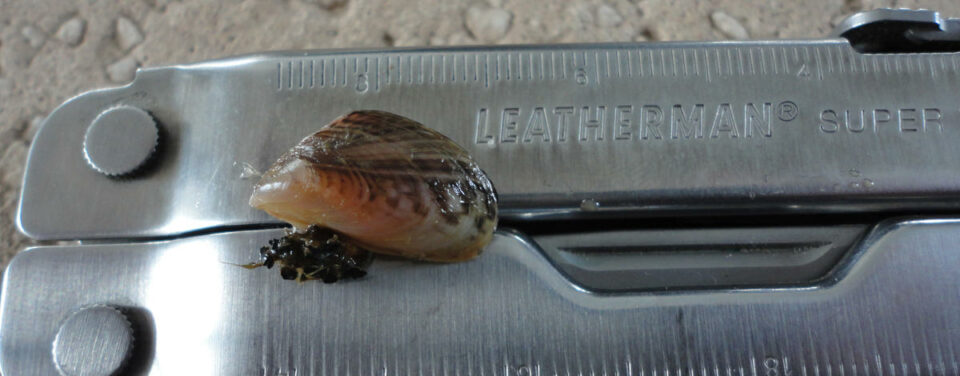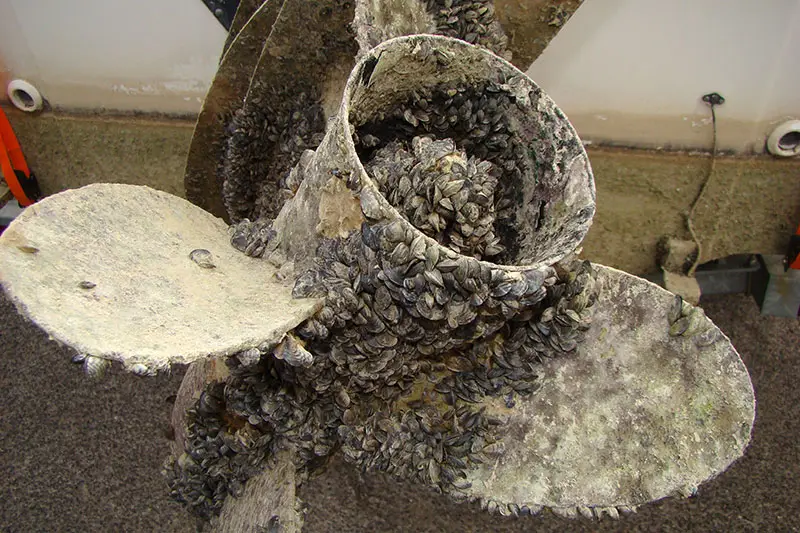Some of you are from states that are in the watery trenches when it comes to fighting Zebra and Quagga mussels, two related and invasive species of bivalve filter feeders that choke up waterways and snatch up nutrients from the water. Quagga mussels have finally made their way to Idaho; what are they, and why should we care about a little mussel?
You might see little coin-sized shelled mussels in any clear body of water in Idaho, as we have our own native species like the Western Pearlshell mussel. These mussels are well integrated into their native ecosystem and hitch a ride as tiny free-floating larvae in the gills of Chinook salmon, which carry them upriver to better waters. The spaces that Chinook spawn are often full of these mussels, including parts of the Salmon River.

Quagga Mussel. Photo Credit: Idaho Fish and Game https://idfg.idaho.gov/article/fish-and-game-amends-hunting-fishing-and-trapping-closure-snake-river-previously-closed-due
Why are these mussels fine to have around, but Quagga or the closely related Zebra mussels need to be eradicated? All mussels are filter feeders and can remove debris and even toxins from the water, but Quagga mussels are too good at it. They suck the good nutrients out of the water and leave eerily crystal-clear water that can’t support other kinds of life, smothering plants and stealing food from invertebrates. They also coat any hard surface they can, making once smooth shore rocks sharp to the touch.

Zebra Mussels. Photo Credit: North Dakota Game and Fish Department. https://gf.nd.gov/ans/species/zebra-mussel
Those local to Idaho, and anyone who fishes the Snake River, may be aware of the use of chelated copper in the river last year that killed hundreds of fish, including several dozen white sturgeon.This action by Idaho Fish and Game paired with the Department of Agriculture seems intense but was needed to prevent the spread of Quagga mussels which were detected in September of last year. Initial application of chemicals did show positive results on killing the invasive mussels, and Idaho Fish and Game will continue to monitor the situation.
What can you do to help? You might have already stopped at a boat check station while driving into Idaho, but that’s not the only time someone will need to scour your watercraft for tiny hitchhikers. You’ll need to visit an Aquatic Invasive Species (AIS) check station for any watercraft, even if it wasn’t in mussel infested waters or already checked somewhere else in Idaho. The folks working those check stations, playfully nicknamed Muscle Men and Quagga Queens between staff here in the SNRA, will check all over your boat and hotwash your craft, if necessary, to prevent contamination between bodies of water. This does, however, exclude blow-up crafts under 10 feet long. After being checked over, you’ll need to purchase an AIS sticker at either the Redfish Visitor Center, Stanley Museum, or the Stanley Ranger Station. These stickers confirm that you’ve had your boat checked and supplies funds to AIS efforts.
This alpine ecosystem is delicate, yet relatively untouched by invasive species. Let’s do our part to keep it that way, and prevent Quagga mussels from reaching our waterways.
Heath is a Naturalist with the Sawtooth Interpretive and Historical Association. He enjoys hiking to hot springs, drawing wildflowers, and birdwatching.